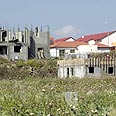
Katzrin
צילום: אפי שריר
Golan olive attractions
Now, there’s even more to see and do in Katzrin, the 'Capital of the Golan'
With the recent opening of the Golan Olive Oil Mill and the Golan Magic Visitor’s Center, there is now even more to see in Katzrin, the so-called “Capital of the Golan”. The two new tourist attractions are located in the city’s industrial zone, near the Golan Wineries and the Mei Eden mineral water bottling plant, both of which have visitor’s centers of their own.
Golan Magic has a new, giant 180 degree screen with a film that presents the area’s fauna, flora, and settlement history. A large three-dimensional model displays the Golan’s topography, communities and nature reserves.
The spacious and airy Golan Olive Oil Mill and Visitor’s Center is a charming building built of basalt stone with wide arches. Set among scattered olive trees sits a hefty olive-pressing stone, a reproduction of a crusher and squeezer, and other artifacts.
Avner Talmon, the mill’s owner, reports that the site’s design was chiefly influenced by the architecture of antique Golan synagogues. Specifically, the broad arches at the entrance were inspired by the imposing structure in Umm El-Kanatir, today known as “Rechavam’s Arches”.
During the olive-harvest season (which begins in October), visitors can watch as olive oil is produced. The entire process, from crushing to bottling, is open to the public, and eventually, tourists will even be able to participate in the harvest itself.
An on-site shop sells the finished products. The site yields approximately 50 tons of olive oil, which is also sold in regional stores throughout the Golan; around 15 tons are designated for export.
Different olive varieties
Today, most Israeli olive presses concentrate on producing oils based on different olive varieties. Since Golan Olive Oil receives olives from seven different growers, extending from the northern Kinneret to the southern Golan, the oil is produced based on flavors, rather than olive varieties.
The taste of the oil changes throughout the harvest season; oil produced from the first olives tends to be dark, with a deep aroma, but the last oil is more delicate, European, favored by chefs, and appropriate for every type of food.
Golan Olive Oil produces three basic flavors of olive oil: Beth Saida, Kursi, and Tabha. Beth Saida is based on classic Israeli cultivars, such as Syrian, Menselino, and Nevali, and enhanced by a bit of Italian. This oil is derived from the early harvest. Kursi is produced from more European cultivars, such as Picholine and Leccino, and is squeezed at the end of the season, when the olives are black.
Tabha, the third flavor, which is also comprised of several varieties, is unique in that the olive pits are removed at the start of the process. Consequently, Tabha oil is more expensive than the other oils, which cost around 50 shekels for a 750 ml bottle.
The Golan Olive Oil Mill Visitor’s Center is opened from 9 am to 5 pm. Closed Saturdays. Tours are by appointment only. Tel. 972-4-6850023.
Antiquities
Visitors to the Golan Olive Oil Mill in Katzrin should also check out two additional nearby attractions: Umm El-Kanatir and the olive press in Ein Nashut.
Staircases and pretty walking paths overlooking the adjacent stream have been added to the ancient synagogue of Umm El-Kanatir, now called “Kashtot Rechavam”, or “Rechavam’s Arches”. Although the synagogue is not yet fully restored, the arches are visible, and visitors can dip in the small pool next to the magnificent fig trees.
Assorted remnants of early olive presses are scattered throughout the grounds. For instance, a finely wrought round basin lies next to the cliff at the northwest edge of the site.
How to get there: Turn west on Route 808 towards Natur. Follow the signs to the dirt road leading to Umm El-Kanatir.
The second site is the synagogue and olive press in Ein Nashut, on the shores of Nahal Mishoshim, about three kilometers north of Katzrin. Clearly marked signs show the way from the main road, and eventually, one has to negotiate over a small creek on protruding rocks and a portion of an ancient culvert.
The small but enchanting synagogue, which was apparently built during the fifth century to serve the village’s needs, remained standing into the seventh century.
Remains of the olive press are situated right next to the synagogue. Artifacts include a basin and an extraction platform. Although there is no real path at this small but unique site, visitors will not want to miss it.
How to get there: Follow the signs on Route 91, slightly east of the Nashut Intersection, to the Ein Nashut synagogue.
Finally, after spending the day on your feet, you’ll want to unwind with a Golan Olive Oil lotion-based massage at the Village Breeze Spa in Moshav Ramot. Don’t count on remembering much of the massage, however; chances are you’ll fall asleep before it’s over.
Later, cross the street to “Chava BaKfar”, where you can revive with a steak and a surprisingly good bottle from the new Maor Winery. Step out onto the balcony of one of the bungalows, and admire the beautiful view of a date orchard and the gleaming Kinneret. Life is good.
Village Breeze Spa and Café, Moshav Ramot. Tel.: (04) 679-7097.










